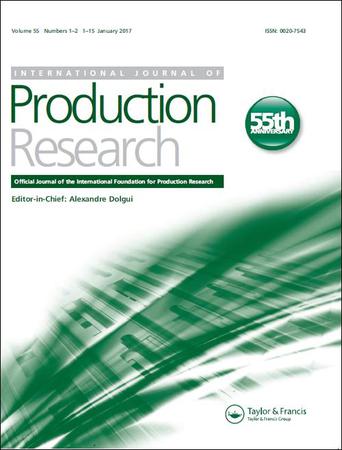供应商网络中的环境因素——一个双目标的准时运输路线问题
IF 7.3
2区 工程技术
Q1 ENGINEERING, INDUSTRIAL
International Journal of Production Research
Pub Date : 2023-09-19
DOI:10.1080/00207543.2023.2258237
引用次数: 0
摘要
摘要货运,包括准时制(JIT)供应商网络,占全球二氧化碳(CO2)排放量的很大一部分。在最近的文献中提出的JIT卡车路线问题(TRP-JIT)包括为单个原始设备制造商(OEM)服务的几个供应商。一家物流供应商负责组织送奶路线。货物在供应商的发布日期之后可用,并应在OEM的到期日期前交付,并尽量减少总迟到罚款(第一个目标)。与之前对TRP-JIT的研究不同,我们关注的是它的环境影响:(1)我们包括了重量-距离(第二个目标),这取决于卡车的整装重量、负载和运输距离。(2)考虑到这两个目标,我们采用了文献中最先进的大邻域搜索(LNS)。(3)将LNS嵌入到双准则框架中,即ε约束和加权和方法。因此,对于99件货物的情况,我们在不到25分钟的时间内估计至少有60个解决方案的帕累托边界。从管理的角度来看,为了获得更好的JIT性能,增加发布和到期日期之间的差异可能会恶化环境影响。较轻的卡车可以在不影响JIT性能的情况下降低环境成本,而较小的车队对这两个目标都有负面影响。关键词:物流即时环境车辆路线大范围搜索披露声明作者未报告潜在的利益冲突。数据可用性声明支持本研究结果的数据(计算研究中使用的实例)可在GitHub上获得https://github.com/jbaals/envtrpjit。这些数据来自以下公共领域的可用资源:Demir, bektau和Laporte的实例(Citation2012),网址:http://www.apollo.management.soton.ac.uk/prplib.htm.Additional information关于贡献者的说明julian Baals julian Baals分别于2016年和2019年在德国达姆施塔特科技大学获得工程管理/工业工程学士和硕士学位。2020年至2022年,在丹麦奥胡斯大学攻读博士学位。自2022年起,他在德国耶拿弗里德里希·席勒大学继续攻读博士学位。他的研究重点是准时物流,特别是通过开发元启发式解决方案程序来优化运输网络。本文章由计算机程序翻译,如有差异,请以英文原文为准。
Environmental aspects in supplier networks-a bi-objective just-in-time truck routing problem
AbstractFreight transportation, including just-in-time (JIT) supplier networks, accounts for a substantial part of the global carbon dioxide (CO2) emissions. The JIT truck routing problem (TRP-JIT) presented in the recent literature consists of several suppliers serving a single original equipment manufacturer (OEM). A logistics provider organises the milk-run routes. The shipments are available after their release dates at the suppliers and should be delivered on their due dates at the OEM with minimal total earliness-tardiness penalties (first objective). Unlike previous research on the TRP-JIT, we focus on its environmental impact: (1) We include the weight-distance (second objective), depending on the truck's curb weight, the load, and the transportation distance. (2) We adapt a state-of-the-art large neighbourhood search (LNS) from the literature considering both objectives. (3) The LNS is embedded in bi-criterial frameworks, i.e. ε-constraint and weighted sum methods. Thereby, we estimate Pareto frontiers with at least 60 solutions in less than 25 min for instances with 99 shipments. From a managerial perspective, increasing the difference between the release and due dates for a better JIT performance may worsen the environmental impact. Lighter trucks can reduce the environmental costs without affecting the JIT performance, whereas a smaller fleet negatively affects both objectives.Keywords: Logisticsjust-in-timeenvironmentvehicle routinglarge neighbourhood search Disclosure statementNo potential conflict of interest was reported by the author(s).Data availability statementThe data that support the findings of this study (instances used in the computational study) are available on GitHub at https://github.com/jbaals/envtrpjit. These data were derived from the following resources available in the public domain:Instances of Demir, Bektaş, and Laporte (Citation2012) at http://www.apollo.management.soton.ac.uk/prplib.htm.Additional informationNotes on contributorsJulian BaalsJulian Baals received a B.Sc. and M.Sc. degree in Engineering Management/Industrial Engineering from the University of Technology in Darmstadt, Germany in 2016 and 2019 respectively. Between 2020 and 2022, he was enrolled as a Ph.D. fellow at Aarhus University, Denmark. Since 2022, he is continuing his Ph.D. studies at Friedrich Schiller University Jena, Germany. His focus is on just-in-time logistics especially the optimisation in transportation networks by developing metaheuristic solution procedures.
求助全文
通过发布文献求助,成功后即可免费获取论文全文。
去求助
来源期刊

International Journal of Production Research
管理科学-工程:工业
CiteScore
19.20
自引率
14.10%
发文量
318
审稿时长
6.3 months
期刊介绍:
The International Journal of Production Research (IJPR), published since 1961, is a well-established, highly successful and leading journal reporting manufacturing, production and operations management research.
IJPR is published 24 times a year and includes papers on innovation management, design of products, manufacturing processes, production and logistics systems. Production economics, the essential behaviour of production resources and systems as well as the complex decision problems that arise in design, management and control of production and logistics systems are considered.
IJPR is a journal for researchers and professors in mechanical engineering, industrial and systems engineering, operations research and management science, and business. It is also an informative reference for industrial managers looking to improve the efficiency and effectiveness of their production systems.
 求助内容:
求助内容: 应助结果提醒方式:
应助结果提醒方式:


